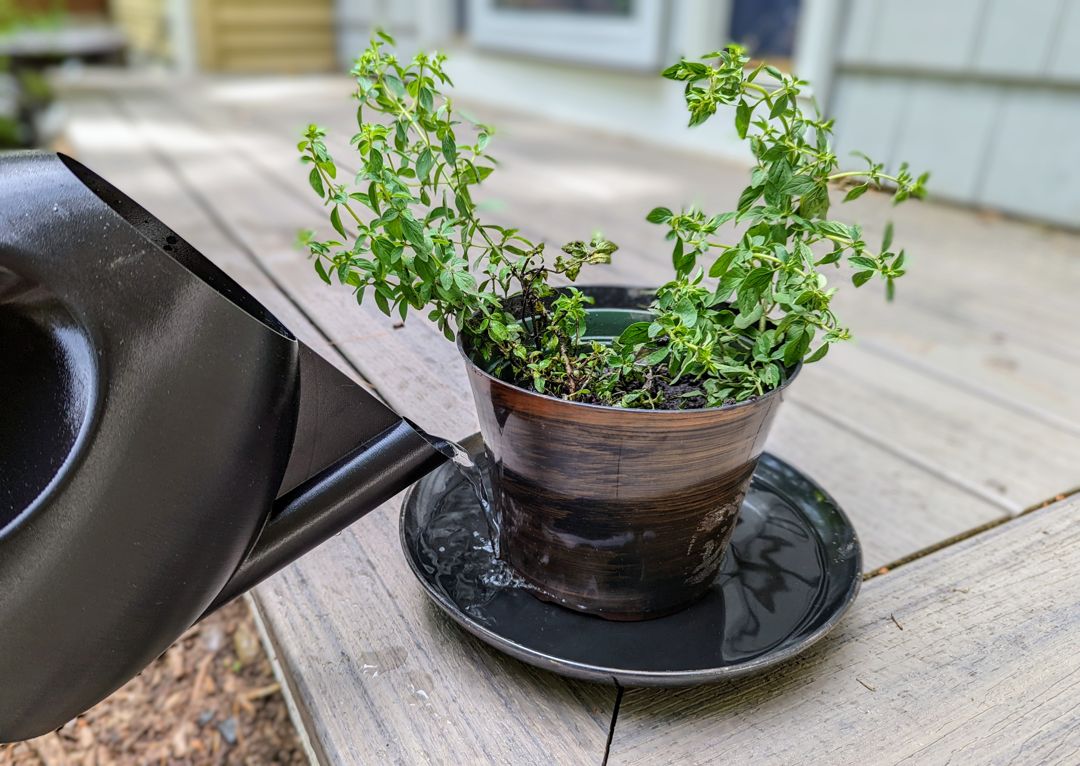Looking for some ways to change up your watering routine? Having troubles with root rot in your container plants or seedling trays? The way that you’re watering could be part of the problem - and we have just the alternative! Bottom watering is a highly recommended practice that may be just the change you need.
What is Bottom Watering?
Most people’s watering strategy is top watering: pouring the water on or around the plant to water the top of the soil and let it drain down. Bottom watering, aka “reverse watering”, is done by placing the bottom of the plant’s container into water and allowing it to soak up the water it needs via capillary action (the same process that drives liquid up a straw or up a paper towel).
Benefits of Bottom Watering
- It is more difficult to overwater when bottom watering.
- Because it doesn’t leave water pooling in the bottom of the pot, bottom-watering plants reduces the likelihood of root rot or fungal infections.
- You won’t be accidentally pouring water over the leaves, which can lead to water sitting in leaf/stem crevices causing rot. Some ornamental plants are particularly sensitive and get discolored and covered in spots if you drop water on the leaves.
- Bottom watering doesn’t splash water onto other plants, so diseases are less likely to spread between plants.
- Bottom watering keeps the soil uniformly moist so the entire root structure gets watered.
- Bottom watering gives the whole root system access to water, promoting a stronger and larger root system as it grows down toward the water source. For veggie gardens, this is particularly important: when growing seedlings with bottom watering, the root systems are deeper and more resistant to dry spells after they’ve been transplanted into the garden.
- Bottom watering doesn’t disturb seedlings’ position in the soil, so it wouldn’t harm the fragile new roots.
Drawbacks of Bottom Watering
- Bottom watering does take more time than top watering, but doesn’t have to be done as often because it thoroughly saturates the soil.
- It requires pots/trays to have drainage holes in them, but really they should have them anyway! Using containers for your plants that don’t have drainage makes it MUCH more likely for root rot to occur.
- Bottom watering isn’t very effective if the dirt is too compact, but top watering isn’t as effective when the soil has large channels for the water to flow right out.
- Watering from the bottom doesn’t flush out excess salt and minerals like top watering does. You’ll need to top water your plants once a month or so to clear out the mineral buildup and avoid root burn.
What Plants Should I Bottom Water? When?
Firstly, let’s cover some some dos and don’ts about when to use bottom watering:
- Bottom watering is best for small to medium sized plants, and seedling trays! It’s not as effective with large pots due to the sheer amount of soil.
- Bottom watering is great for plants with sensitive leaves, but not as good for plants with roots sensitive to salt buildup in the soil. Never hurts to check!
- If you use a humidity dome, it doesn’t matter the time of day that you bottom water; otherwise, it’s best to water at the most humid times of day so the least amount of water is lost through the leaves. In most cases, those times are the morning and late evenings.
Now, for the important bit: the how!
- Test if your plant needs water by your finger into the soil. If you push down to the second knuckle and still don’t feel moist soil, it’s time to water!
- Put a large dish under your pot, or a larger seed tray with no drainage under your seedling tray.
- Pour the water into the dish/tray; it’s fine if it’s a lot, the plant will take in what it needs.
- Exactly how long you let your plant sit in water depends on their size and how dry they are - 10 minutes is a good length, but check in on it occasionally. Let your plants drink until the soil just under the surface is moist (like a sponge, not wet) to the touch.
- Lift the pot/tray out of the water, and let it drain out the excess water. You’re done!
I don’t have dishes or trays like that!
Well, good news! Most pots with drainage holes come with trays to match, but round plastic trays like these can be found cheap just about anywhere! Some seed starter trays like this one come with trays for bottom watering, or you can also get pots like this or this with a setup built into them for it! Otherwise, there’s trays like this for putting under your seedling starter trays!
The Science: How Plants Carry Water
Plants cycle through water through a process called transpiration; During the day, the sun’s heat evaporates water from tiny pores in the leaves called stomata. As water leaves the system there, more water is drawn up through the xylem (the primary circulatory channel in a plant) all the way up from the roots! Think of it like a syringe; if you pull away the handle (in this case, the water leaving the leaves), liquid is pulled into the syringe at the bottom (water coming in the roots). Between transpiration and capillary action, a tree can get its water and nutrients far above the ground, against gravity, with no muscles - simply driven by the sun’s heat!
